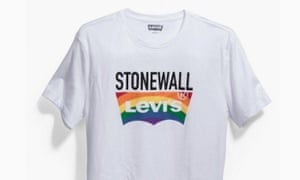russellrus
russell's fashion blogFashion is about self-expression, where saying who you are and what you stand for – and wearing the clothes that back that up – is not only acceptable, it is encouraged. While the labels you choose to wear might do that implicitly, a slogan T-shirt quite literally spells it out. And it is these that are in the frame at the moment, with gay – sometimes explicit – slogans appearing on recently released T-shirts.
Levi’s releases its second Pride collection this month, timed to reach stores before the march in the US. The collaboration with the Stonewall Community Foundation, which will receive a portion of the sales, includes rainbow-flagged T-shirts reading “Stonewall Levi’s”, and a timeline of gay rights printed on the back of vests. The rainbow motif – hardly subtle, but certainly recognisable – continues on short shorts, caps and denim jackets with patches. The clothing line reflects the kind of clothes activists would have worn on demonstrations in 1969 – a clever move when the late 60s/early 70s aesthetic is having a bit of a moment.
unique bridesmaid dresses
Elsewhere, there is a bolder take on fashion for the LGBTQ consumer. Opening Ceremony collaborated with an Aids awareness association, Act Up, on T-shirts using their slogan “Silence = Death” in 2013. Ollie Henderson’s Freedom collection features T-shirts that read: “Some boys love cock” and “Some girls love cunt” – a little bit more explicit, then, but as Henderson has said, open to all. Her T-shirts (for House of Riot) are designed to be worn by anyone who wants to express their “solidarity with the fight of anyone whose freedom is restricted”, and 20% of the sales of each T-shirt is donated to an Australian charity helping LGBTQ teenagers.
But, charity element aside, does turning yourself into a sandwich board get the message across? Or is the idea of “gay fashion” another form of ghettoisation? Daryoush Haj-Najafi, a senior editor at Complex UK, thinks it should be applauded, and that it is part of fashion’s love of self-expression. “Wearing anything that isn’t mainstream fashion is a form of activism really, but we should still celebrate people wanting their clothes to say something,” he says. “I definitely feel freer and therefore happier if I feel people are open to discussing things.”
Perhaps clothes like this are about starting a conversation, either through looking back to the history of gay culture or getting straight to the point, as with Henderson’s T-shirts. Making issues undeniably visible is the power of the slogan T-shirt. That is been the case since Katherine Hamnett wore her “58% don’t want pershing” T-shirt to meet Margaret Thatcher in 1983. The issues might be different, but the medium remains as powerful.
kissy lace bridesmaid dresses




